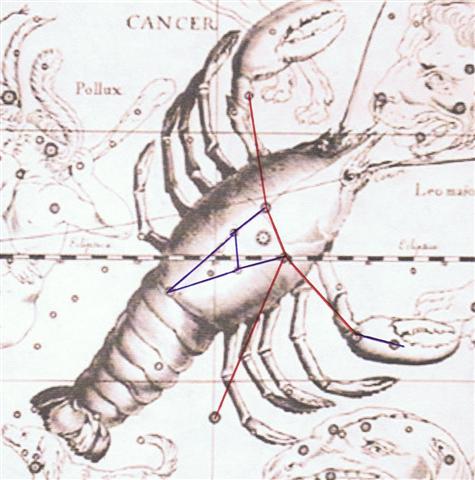The 10th hour is beginning 137 days after March 21, which resembles how the first manzil, Sheratan, is beginning 137 days counted from January 1. 216 = 80 + 136.
Its end is with Gregorian day 231, 151 days counted from March 21 and 80 days from May 31. 231 = 80 + 151.
 |
 |
 |
 |
| Ka4-7 |
Ka4-8 (70) |
Ka4-9 |
Ka4-10 (*136) |
| |
ζ Hydrae (134.1) |
Acubens, Talitha Borealis (135.0) |
ρ Ursa Majoris (135.6), ν Cancri (136.0), Talitha Australis (136.1) |
| August 1 |
2 |
3 |
4 (216) |
| Alhena 11 (77) |
12 |
13 |
Murzim 1 (80) |
 |
 |
 |
| Ka4-11 (73) |
Ka4-12 |
Ka4-13 |
| ω Hydrae (136.8), σ¹ Ursa Majoris (137.0), κ Cancri (137.3), τ Cancri (137.4), Alsuhail (137.5) |
σ² Ursa Majoris (137.6), τ Ursa Majoris (137.7), ξ Cancri (137.8) |
θ Hydrae (138.9), π Cancri (139.2), Miaplacidus (139.3) |
| 9h (137.0) |
August 6 (218) |
7 |
| Murzim 2 (81) |
3 |
4 |
 |
 |
 |
 |
| Ka4-14 (*140) |
Ka4-15 (77) |
Ka4-16 |
Ka5-1 |
| Tureis (139.8) |
|
Al Minhar al Asad (141.6), Alphard (142.3) |
ω Leonis (142.6), τ¹ Hydrae (142.7), Alterf, τ² Hydrae (143.4), ξ Leonis (143.5) |
| August 8 |
9 |
10 (222) |
11 |
| Murzim 5 |
6 (85) |
7 |
8 |
 |
 |
 |
 |
| Ka5-2 (80) |
Ka5-3 |
Ka5-4 |
Ka5-5 |
| A Hydrae (144.1) |
Ukdah (145.4), κ Hydrae (145.5) |
Subra (145.8), ψ Leonis (146.4) |
Ras Elaset Australis (146.6) |
| August 12 |
13 (225) |
14 |
15 |
| Murzim 9 (88) |
10 |
11 |
12 |
 |
 |
 |
 |
 |
| Ka5-6 (84) |
Ka5-7 |
Ka5-8 (*150) |
Ka5-9 |
Ka5-10 |
| υ¹ Hydrae (148.4) |
Ras Elaset Borealis (148.7) |
ν Leonis (150.1) |
π Leonis (150.6) |
υ² Hydrae (151.8), Al Jabhah (152.4) |
| August 16 (228) |
17 |
18 (230) |
19 |
10h (152.2) |
| Murzim13 (92) |
An Nathra 1 |
2 |
3 |
4 |
A sign of separation with a new little one in front - similar to that in Ka3-18, though here like a throwing stick - comes with the last day in the Murzim manzil. Tagata (with a comparatively flat head) probably illustrates how the preceding season is completed, 8 weeks beyond June 21. 172 + 56 = 228 = 92 + 136.
228 = 12 * 19. If we add another 136 days to 228 (August 16) we will reach December 30, which date seems to have been documented in G as follows:
 |
 |
 |
 |
 |
| Ga8-17 |
Ga8-18 (222) |
Ga8-19 |
Ga8-20 |
Ga8-21 |
| λ Cor. Austr. (283.6), Double Double (283.7), ζ Lyrae (283.8), φ Sagittarii (284.0) |
μ Cor. Austr. (284.6), η Cor. Austr., θ Pavonis (284.8), Sheliak, ν Lyrae (285.1) |
λ Pavonis (285.7), Ain al Rami (286.2), δ Lyrae (286.3) |
κ Pavonis (286.5), Alya (286.6), ξ Sagittarii (287.1), ω Pavonis (287.3), ε Cor. Austr., Sulaphat (287.4) |
λ Lyrae (287.7), Ascella (287.9), Nunki (288.4) |
| December 30 |
31 |
January 1 (366) |
2 |
3 |
| 6 |
7 |
8 |
Qalb al Akraab 9 |
Shaula 1 (232) |
The measure 92 equals the distance from March 21 to June 21. Murzim 13 can therefore allude to June 21.
The following manzil, An Nathra (a name illustrating separation because it has two parts), begins after the separation illustrated in Ka5-6 (where we can imagine 5-6 = 56 = 228 - 172). Gregorian day 200 is July 19 and 4 weeks after June 21. This is where the henua calendar is beginning:
 |
 |
 |
 |
 |
| Ka3-15 (*120) |
Ka3-16 |
Ka3-17 |
Ka3-18 (59) |
Ka3-19 (*124) |
| χ Carinae (119.9). ω Cancri (120.4) |
Naos (121.3) |
Heap of Fuel (122.1) |
Tegmine (123.3) |
Al Tarf (124.3) |
| July 19 (200) |
20 |
8h (121.7) |
22 |
23 (204) |
| Heka 11 (64) |
12 |
13 |
Alhena 1 |
2 (68) |
| Nawaa |
Manzil |
Begins on |
Number of days |
Stars |
| Kulaibain |
An Nathra |
17 Aug (229) |
13 |
105 |
An Nathra |
| Suhail |
Alterf |
30 Aug (242) |
13 |
118 |
Alterf |
| Dschuba |
12 Sept (255) |
13 |
131 |
Dschuba |
| Azzubra |
25 Sept (268) |
13 |
144 |
|
| Assarfa |
8 Oct (281) |
13 |
157 |
|
... The manzil An Nathrah, the Gap in the hair under the muzzle of the supposed immense ancient Lion, was chiefly formed by Praesaepe [Beehive, ε Cancri] ...
 |
 |
 |
| Ka4-4 (*130) |
Ka4-5 |
Ka4-6 (68) |
| π¹ Ursa Majoris, δ Hydrae (129.6), Al Minhar al Shujā, Museida (129.9), Beehive (130.4) |
Ascellus Borealis (130.9), η Hydrae (131.0), Ascellus Australis (131.4) |
ε Hydrae (131.9), ι Cancri (132.0), ρ Hydrae (132.4) |
| July 29 |
30 |
31 (212) |
| Alhena 8 |
9 |
10 |

The measure 136 days may ultimately originate from the star Atlas which is rising together with Pleione. Atlas is the only male among the Pleiades:
| |
(80 + RA / 24h * 365¼) |
|
Day of culmination |
|
| Atlas |
'May 16 (136) |
228 |
'December 31 (365) |
135 |
| |
56 |
-3 |
53 |
+3 |
| Castor |
'July 12 (193) |
225 |
'February 23 (419) |
138 |
| New year (?) |
| Atlas - Castor |
58 days |
227 (π) |
355 |
365 |
| 'July 13 (194) |
| Procyon - Vega |
168 days |
| - Altair |
18 days |
128 |
| - Menkar |
110 days |
| - Atlas |
10 days |
I have noted π at number 227 because it can allude to 22 / 7 (= 3.14). Menkar is α Ceti and not the same star as Minkar (ε Corvi).
It was the mighty Atlas who carried the star globe on his shoulders:

|
























